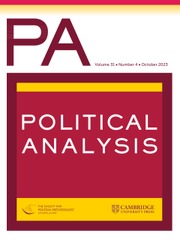Article contents
Estimating the Causal Effects of Social Interaction with Endogenous Networks
Published online by Cambridge University Press: 04 January 2017
Abstract
Identifying causal effects attributable to network membership is a key challenge in empirical studies of social networks. In this article, we examine the consequences of endogeneity for inferences about the effects of networks on network members' behavior. Using the House office lottery (in which newly elected members select their office spaces in a randomly chosen order) as an instrumental variable to estimate the causal impact of legislative networks on roll call behavior and cosponsorship decisions in the 105th–112th Houses, we find no evidence that office proximity affects patterns of legislative behavior. These results contrast with decades of congressional scholarship and recent empirical studies. Our analysis demonstrates the importance of accounting for selection processes and omitted variables in estimating the causal impact of networks.
- Type
- Research Article
- Information
- Copyright
- Copyright © The Author 2012. Published by Oxford University Press on behalf of the Society for Political Methodology
Footnotes
Authors' note: We thank Sara Brady, James Fowler, Keith Poole, Keith Krehbiel, and Jonathan Woon for providing data used in this project. We thank Kevin Collins, David Darfomal, James Fowler, Rob Franzese, Donald Green, Greg Huber, Greg Koger, Seth Masket, Eric Oliver, Jennifer Victor, Nick Weller, and participants of the Fourth Annual Political Networks Conference and the Harris School Political Economy Lunch for lively discussion and helpful comments. The editors and two anonymous reviewers provided especially conscientious feedback. We are most indebted to John J. Pitney, who used his own social networks to help us locate the House lottery data. This research protocol (H10171) was approved by the University of Chicago IRB. Supplementary materials for this article are available on the Political Analysis Web site.
References
- 43
- Cited by


